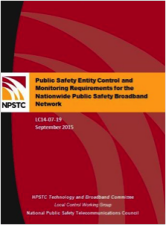October 13, 2015

National Public Safety Telecommunications Council
The National Public Safety Telecommunications Council (NPSTC) has been working on broadband requirements since 2009 with the publication of its 700 MHz Public Safety Broadband Task Force Report and Recommendations. The Act establishing the First Responder Network Authority requires FirstNet to actively consult with public safety about its various needs. Now NPSTC is pleased to present its latest report and recommendations to the Public Safety Advisory Committee (PSAC) for consideration by FirstNet.

Public Safety Entity Control and Monitoring Requirements for the Nationwide Public Safety Broadband Network outlines public safety's needs and expectations for Local Control of the Local Control Report NPSBN. For the purposes of the NPSTC document, a Public Safety Entity (PSE) is defined as federal, state, local, and tribal public safety organizations, that use communications services from the NPSBN to provide public safety services in response to an incident or planned event.
"Local Control" means the ability of PSEs at all jurisdictional levels -- federal, state, local, and tribal -- to configure and monitor their communications systems to adapt to changing mission requirements and system conditions. The phrase "changing mission requirements" denotes a situational continuum ranging from routine to crisis.
The central dilemma of Local Control in a shared network environment is a balancing of the genuine need of PSEs to independently configure their communications with the equally important political and social need to share resources equitably among primary NPSBN-users (i.e., police, fire, and EMS).

The resolution of this dilemma requires attention to people, process, and technology including: Changes in a PSE user's perception of "their" communications network; facilitated inter-agency processes and educational opportunities; and technical means for avoiding inefficient use of shared capacity or resources that would cause a negative impact on the network.

Join Us on Social Media
NPSTC Outreach News and Related Public Safety News are now available on NPSTC's blog.
Click on the orange icon above to check it out.
Click on the orange icon above to check it out.
NPSTC is a federation of organizations whose mission is to improve public safety communications and interoperability through collaborative leadership.
Support provided by the U.S. Department of Homeland Security's Science and Technology Directorate, Office for Interoperability and Compatibility, and the National Program and Protection Directorate, Office of Emergency Communications. Points of view or opinions expressed are those of the originators and do not necessarily represent the official position or policies of the U.S. Department of Homeland Security.
American Association of State Highway and Transportation Officials | American Radio Relay League | Association of Fish and Wildlife Agencies | Association of Public Safety Communications Officials | Forestry Conservation Communications Association | International Association of Chiefs of Police | International Associate of Emergency Managers | International Association of Fire Chiefs | International Municipal Signal Association | National Association of State Chief Information Officers | National Association of State Emergency Medical Services Officials | National Association of State Foresters | National Association of State Technology Directors | National Council of Statewide Interoperability Coordinators | National Sheriffs' Association | National Emergency Number Association
National Public Safety Telecommunications Council | 8191 Southpark Lane | Unit 205 | Littleton | CO | 80120









